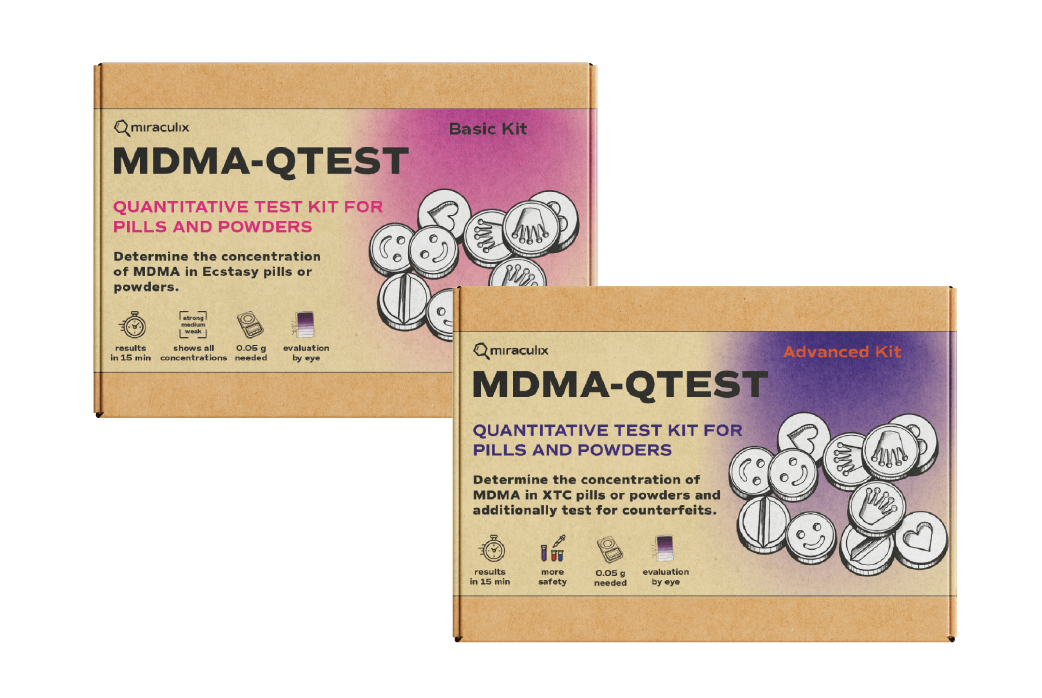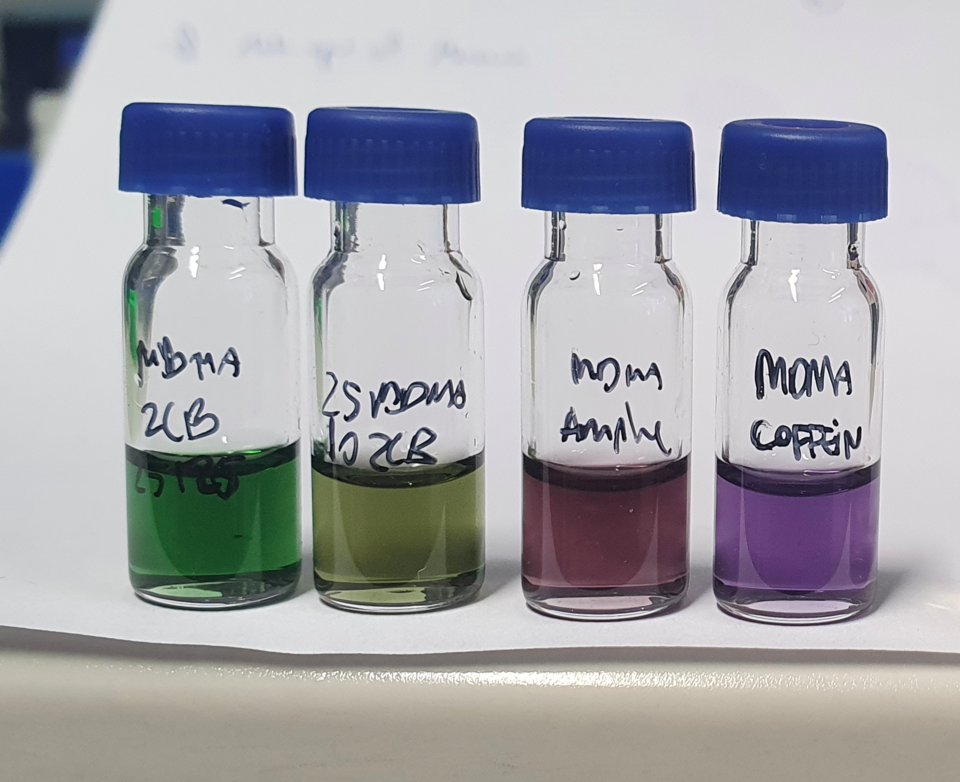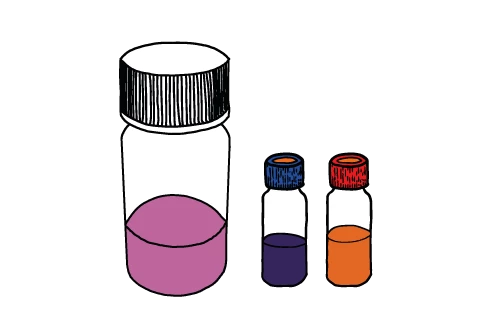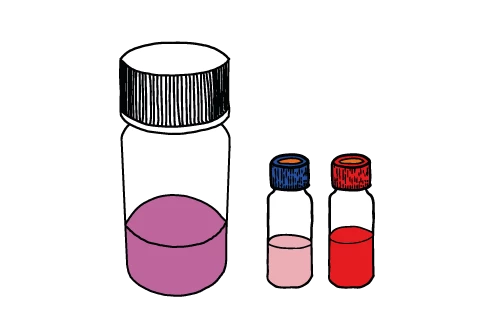
THE MDMA-QTest
If you know in advance what and how much is in them, you can control your experience more consciously or have good reasons to change your mind. Especially with unknown pills, powders or crystals, you always have only vague information about their composition.
With the MDMA QTest not only the content of active ingredients can be determined, but also dangerous additives can be detected immediately.
Translated with DeepL
Additional information MDMA-QTest
On this page we would like to provide you with additional material and information for our MDMA-QTest, which should support you in the implementation and evaluation. For example, we will provide you with comparative images for evaluation or describe how best to set up and carry out the evaluation.
If there are things that we have not yet listed here, but that lead to questions for you, then you are welcome to write to us at any time.

Color series MDMA-QTest
The color row shows the individual color levels for the evaluation of the MDMA-QTest. Each color thus stands for a direct color field. This would mean that we see the following values from left to right:
- 0 mg, 4 mg, 8 mg, 12 mg, 16 mg, 20 mg, 24 mg, 28 mg, 32 mg
This image* is intended to help you assess if you have difficulties in estimating the correct color field. *Please remember that colors can look different on every screen. In addition, the picture was taken with small glasses in the laboratory. You will use larger vials during the procedure. The images are therefore only intended as an aid and estimation.
Color developments for mixtures
Unknown pills or powders can always be mixed with other psychoactive substances. Our MDMA-QTest indicates a mixture with other active substances from the very first color development. These can be recognized immediately with the naked eye.
For example, substances such as 2C-B or amphetamines can be detected. If the detection reagent does not turn purple for supposed MDMA, a mixture with other substances can already be assumed.
Note: The vials used do not correspond to the vials you use when carrying out the QTest and are for reference and illustrative purposes only

„Mislabeling/Addition of Other Substances“
The large glass vial, after adding the substance, does not show a purple coloration but instead:
- A strong green discoloration: the substance is very likely mislabeled and contains 2C-B instead of MDMA. This is confirmed by a strong red discoloration in the small vial with the red cap.
- A yellowish-orange discoloration: the substance is very likely mislabeled and contains amphetamines instead of MDMA. This is confirmed by a strong red discoloration in the small vial with the red cap. In this case, if the small vial with the blue cap turns purple/blue, it also suggests an addition of caffeine and/or methamphetamine. For more precise information, additional analyses such as antibody strip tests would be required.
- No discoloration at all, even after directly adding the substance to the large detection vial: the substance is very likely mislabeled and may contain other substances. If in this case, the small vial with the red cap turns strongly red, the sample probably contains contamination with PMA. On the other hand, if the small vial with the blue cap reacts and turns purple/blue, it suggests an addition of PMMA in the sample. For more precise information, additional analyses would be required (Refer to section 5, „Limitations“).
- A mixture of different colors indicates a mixture of different substances.
If there is contamination or mislabeling, determining the concentration of the active ingredient is no longer possible.
Frequently asked questions about the MDMA-QTest
Here you will find the answers to frequently asked questions:
Yes, this is easily possible. Our rapid test can be used for crystals. Just make sure that the amount of starting material is reduced. Only 30 mg is required for the test instead of 50 mg (as with pills).
Fillers such as sugar or starch, including colored ones, which are always contained in pills for shaping, strongly influence the results of classic color tests and thus make them unusable. Due to integrated purification, the MDMA-QTest can also be used for colored pills and powders and provides reliable results.
To ensure that the concentration can be calculated for the entire pill, you should weigh it once in advance and make a note of the weight. Then homogenize the pill completely and perform the MDMA-QTest. The result that you have determined with the color scale can be used to determine the total value.
We will give you a calculation example for this:
The evaluation using the color scale indicates a concentration of 16 mg. Your starting material (e.g., a pill) has a total weight of 520 mg.
= concentration x (Tablet weight / 50 mg)
= 16 mg x (520 mg / 50 mg)
= 166.4 mg
With the MDMA-QTest it is possible to find out quickly and easily whether the unknown substance is the main active ingredient MDMA or another substance. Mixtures can also be detected directly. There are the following indications for this:
- If the large detection reagent turns a strong green color, the substance is very likely mislabeled and contains 2C-B instead of MDMA.
- A yellowish-orange discoloration of the substance is highly likely mislabeled and contains amphetamines instead of MDMA.
- No discoloration at all, even after directly adding the substance to the large detection vial: the substance is very likely mislabeled and may contain other substances.

